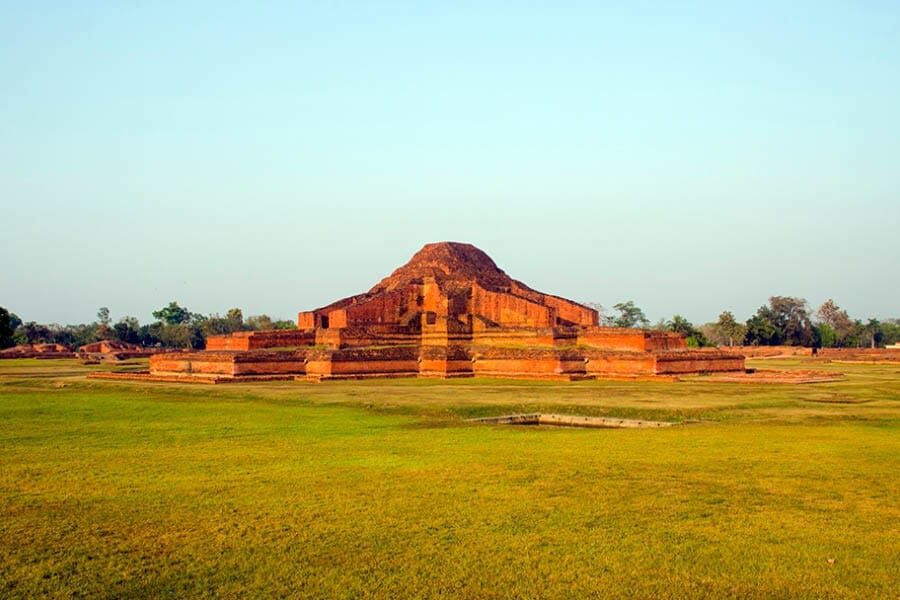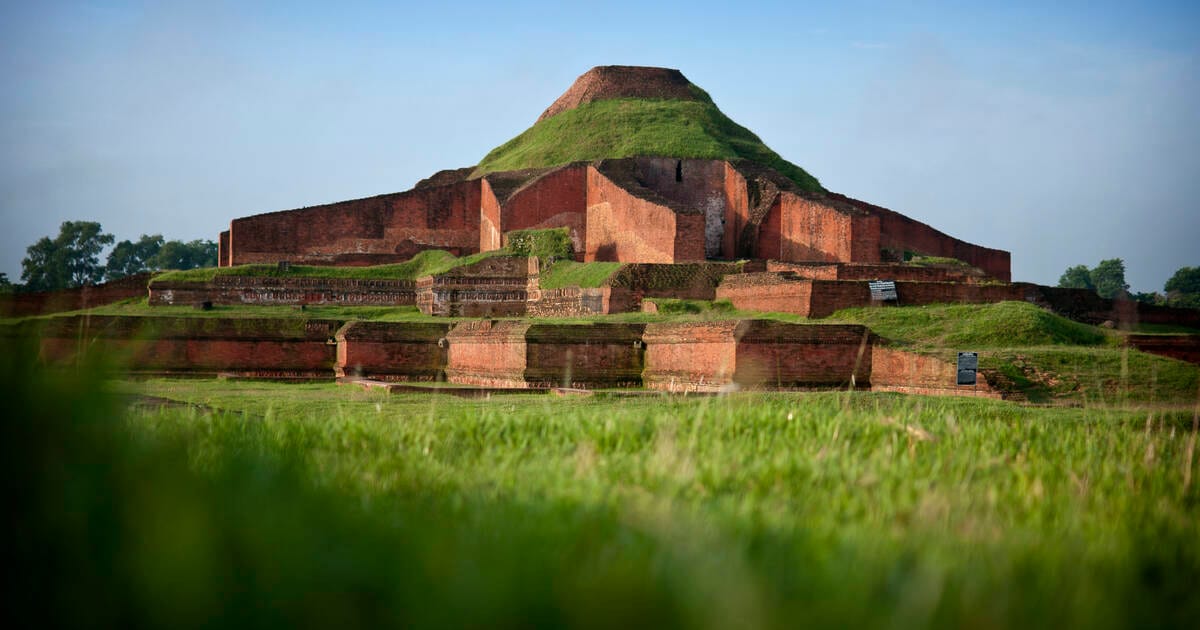Some trips don’t just stay in your memory—they live there. Paharpur Buddha Bihar is one of those places for me. I visited it many years ago when I was still very young, maybe not even fully able to understand its history. But I remember the day clearly. We had gone near Bihar to attend a marriage ceremony with my uncle and cousin. It was one of the first historic places I had ever seen in my life. And now, when I think about it, it is more than just a tourist spot for me—it’s a memory of my uncle, who is no longer here.
Table of Contents
ToggleThe Journey to Paharpur
It wasn’t a planned tourist trip. We were there for a wedding, full of relatives, laughter, and noise. But my uncle—he was the kind of person who loved showing us new things—suggested we go see the famous Buddha Bihar in Paharpur. I didn’t know much about it then. To be honest, I was just excited about going somewhere outside the wedding venue.
I remember the road. Long stretches of green fields, small shops by the roadside, children waving at strangers. My cousin and I were in the back seat, arguing about snacks and taking turns to sit by the window. My uncle drove, talking to us, teasing us, telling us the story of the place in bits and pieces. I didn’t even know how important that conversation would be in my life until much later.
First Glimpse Of Paharpur Buddha Bihar
When we reached, I saw this huge open area, and in the middle stood the ruins—old, brown, and silent, yet speaking a thousand stories. Paharpur Buddha Bihar (Somapura Mahavihara) is not just a ruin; it is a piece of history from the 8th century, built by the Pala dynasty. But at that time, I didn’t care about history books. I only cared about how it made me feel. And it felt… big. Bigger than anything I had seen before.
The air was quiet there, except for the sound of the wind. The bricks looked worn out but strong, as if they had fought against time itself. My uncle walked ahead, and I ran behind him. He kept pointing at different parts, telling me how monks once lived here, studied here, prayed here. I could see his eyes light up when he spoke. Maybe that’s why I remember it so vividly—not because of the place itself, but because of how he made it come alive for me.


Walking Through History
We went inside the ruins, stepping carefully over the uneven ground. I tried to imagine monks in saffron robes walking here centuries ago. The walls were thick, the corridors narrow. Some rooms still had outlines of doors and windows, though they were broken and faded. I touched the bricks. They were rough, a little warm under the afternoon sun.
My cousin and I played hide and seek among the walls while my uncle watched with a smile. He didn’t rush us. He let us feel the place in our own way. Sometimes he would call us over to show a carving or a stone that looked different. I didn’t understand its archaeological value back then, but I understood that it was special.
The Memory That Changed Over Time
Back then, it was just a fun outing during a wedding trip. But now, it’s a bittersweet memory. My uncle is gone, very suddenly, without warning. When I think of Paharpur now, I see his smile, hear his voice telling stories, feel his hand on my shoulder guiding me along the path. That visit has become more than just a travel memory—it’s a reminder of the time we had together.
Sometimes places hold pieces of the people we love. Paharpur does that for me. Every brick feels like it carries a part of my uncle’s laughter, every shadow feels like he is still there walking ahead of me.
Learning About Its Past
Years later, when I was old enough to read about history, I found out that Paharpur Buddha Bihar is actually called Somapura Mahavihara. It is one of the most important Buddhist monasteries of the ancient world and is now a UNESCO World Heritage Site. Built in the late 8th century by King Dharmapala of the Pala dynasty, it was once a thriving center of learning, much like Nalanda in India.
But when I was standing there as a child, history was not about dates and dynasties—it was about imagining. My uncle told me how monks from different countries used to come here to study philosophy, medicine, and scriptures. He said it was like a big school, but instead of math and science, people learned how to live in peace. I remember him using his hands to show how big the place must have been when it was new. I stood there, trying to see it in my mind—the walls unbroken, the courtyard filled with people, the sound of chanting in the air.
A Place That Feels Alive Even in Ruins
Even though much of Paharpur is in ruins now, there’s a strange life in it. The main central temple still rises above the ground, surrounded by what used to be the monks’ living quarters. You can walk around and see the outlines of the rooms—small, simple, but arranged with purpose. There are still some terracotta plaques on the walls, with carvings of stories from Buddhist teachings.
HistoryHit’s article explains how Somapura was one of the five great Mahaviharas of the Pala period, connected with others across the region.
As a kid, I didn’t think much about those carvings. I thought they were just decorations. My uncle bent down and pointed to one of them, tracing it with his finger. “This is history speaking,” he said. I didn’t fully get it then, but now I do. Those small details are like whispers from another time.
The Sky Above Paharpur
One thing I remember so clearly from that day is the sky. It was huge. No tall buildings, no wires cutting across—just open blue stretching forever. Standing there, it felt like the sky and the ruins were having a conversation, like they had been together for centuries, watching everything change and yet staying the same.
We sat on the grass for a while, eating some snacks my uncle had brought. I can still taste the puffed rice and fried lentils we shared. It’s funny how such a simple snack can stay in your memory for decades just because of where and with whom you ate it.
The Last Look Before Leaving
When we left, I remember turning back one last time to look at the site. The afternoon sun had started to dip, casting long shadows across the walls. My uncle stood next to me, also looking back. He put his hand on my head and said, “One day, you’ll come here again and remember this.”
At that time, I didn’t know how much weight those words would carry. Now, they feel like a promise I still have to keep.



